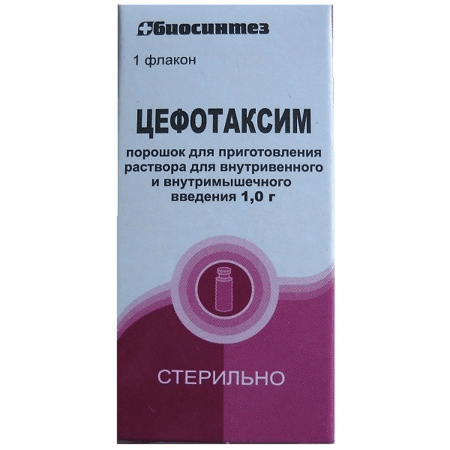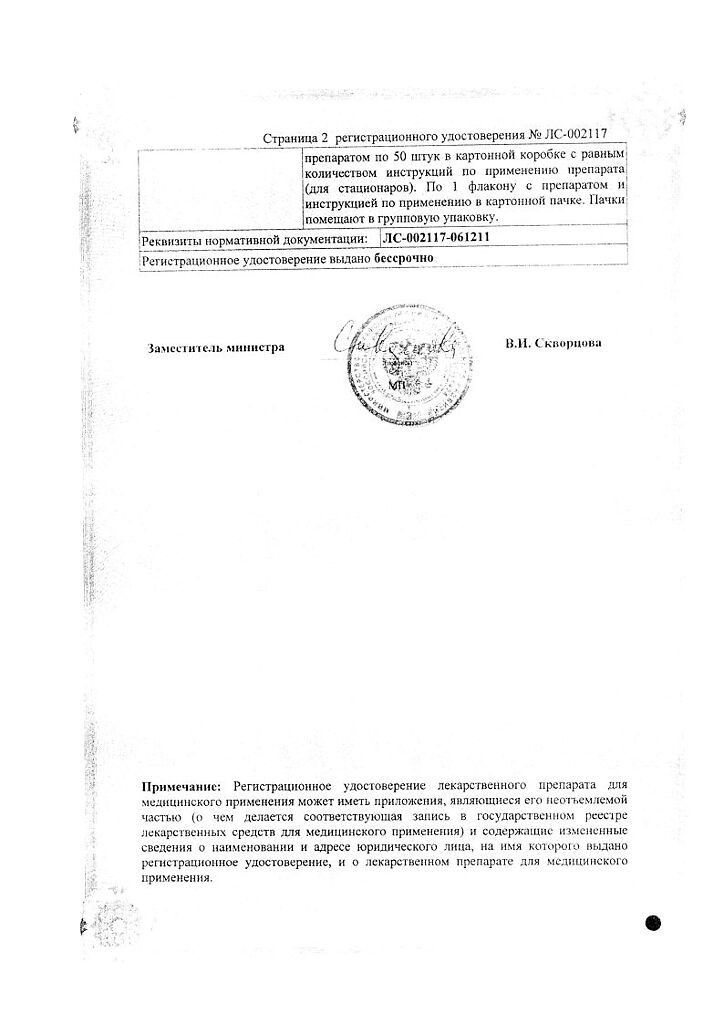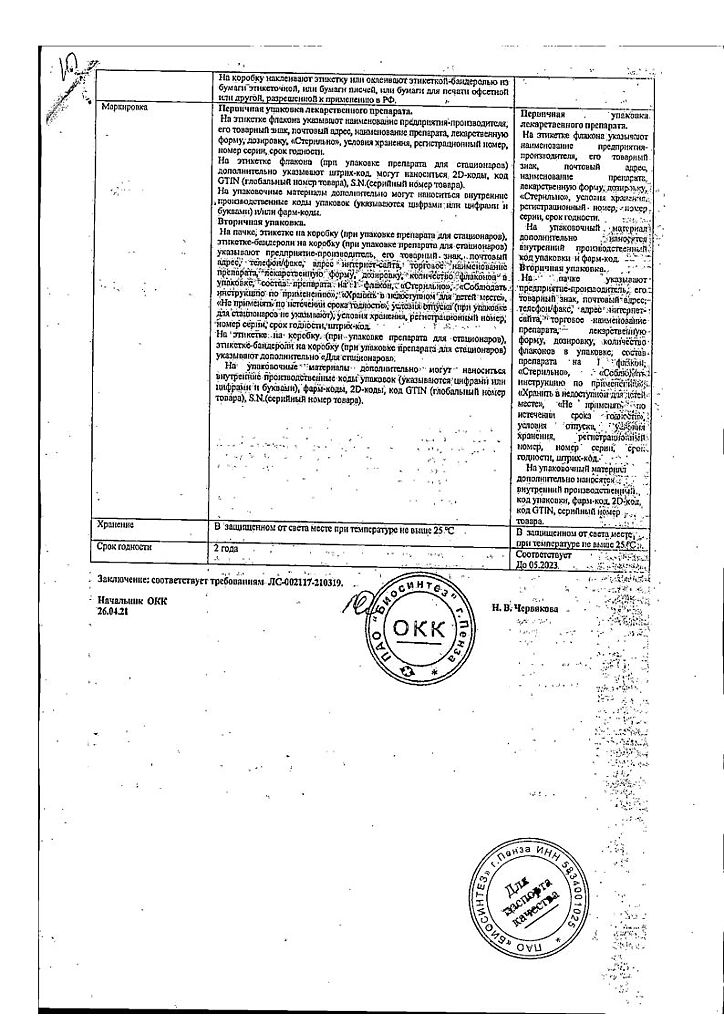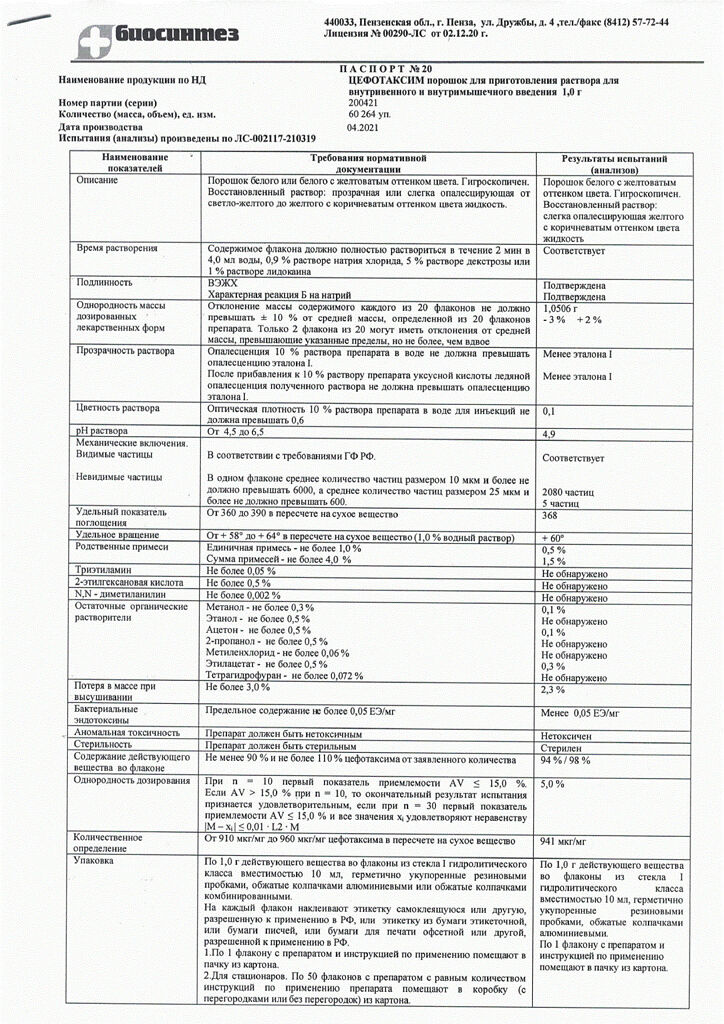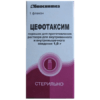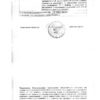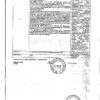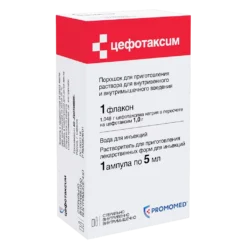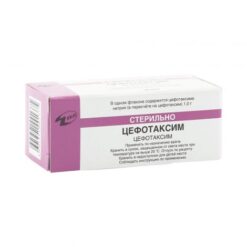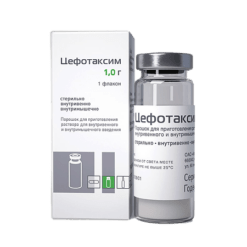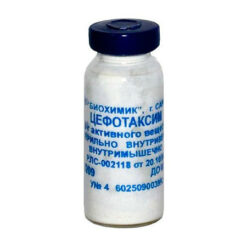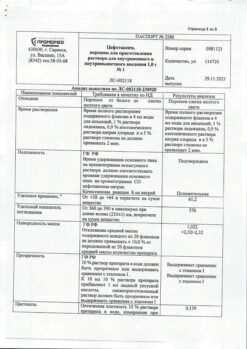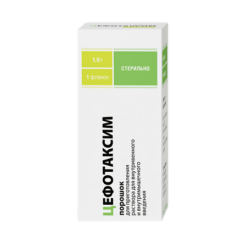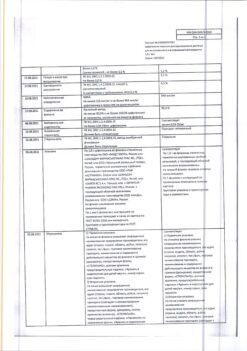No products in the cart.
Cefotaxime, 1 g
€1.08 €0.98
Out of stock
(E-mail when Stock is available)
Description
Pharmacodynamics
Cefotaxime is a III generation cephalosporin antibiotic for parenteral use. It acts bactericidally. It has a broad spectrum of antimicrobial action.
Active against Gram-positive and Gram-negative microorganisms resistant to other antibiotics: Staphylococcus spp.including Staphylococcus aureus, including penicillinase-producing strains), Staphylococcus epidermidis, Streptococcus pneumoniae, Streptococcus pyogenes, Streptococcus agalactiae, Enterococcus species, Enterobacter spp, Escherichia coli, Haemophilus influenzae (including penicillinase-producing strains), Haemophilus parainfluenzae, Klebssiella spp.pneumoniae), Morganella morganii, Neisseria gonorrhoeae (including penicillinase strains), Acinetobacter species, Corynebacterium diphtheriae, Erysipelothrix insidiosa, Eubacterium spp, Propionibacterium spp, Bacillus subtilis, Clostridium spp. (including Clostridium perfringens), Escherichia coli, Citrobacter spp., Proteus mirabilis, Proteus indole, Proteus vulgaris, Providencia spp. (including Providencia rettgeri), Serratia spp, Pseudomonas aeruginosa, Neisseria meningitidis, Bacteroides spp. (including some strains of Bacteroides fragilis), Fusobacterium spp. (including Fusobacterium nucleatum), Peptococcus spp.
Resistant to most beta-lactamases of Gram-positive and Gram-negative microorganisms, Staphylococcus penicillinase, Clostridium difficile.
Pharmacokinetics
After a single intravenous administration of 0.5, 1 and 2 g, the maximum concentration (Cmax) is reached in 5 minutes and is 39 µg/mL, 100 µg/mL and 214 µg/mL, respectively. After intramuscular 0.5 and 1 g, Cmax is reached after 0.5 hours and is 11 and 21 µg/ml, respectively. The binding to plasma proteins is 25-40%.
It creates therapeutic concentrations in most tissues (myocardium, bone, gallbladder, skin, soft tissue) and body fluids (synovial, pericardial, pleural, sputum, bile, urine, cerebrospinal fluid). Volume of distribution is 0.25-0.39 l/kg.
The half-life (T½) with intravenous and intramuscular administration is 1 hour.
The kidneys excreted 60% – 70% unchanged, the rest – as metabolites (the deacetylated derivative has bactericidal activity, and 2 other metabolites have no activity).
In chronic renal failure (CKD) and in elderly persons the T½ increases by 2 times. T½ in neonates is 0.75-1.5 hours, in premature infants increases to 4.6 hours. No cumulation is observed after repeated IV doses of 1 g every 6 hours for 14 days. It penetrates into breast milk.
Indications
Indications
Severe bacterial infections caused by sensitive microorganisms:
chlamydia,
gonorrhea,
infected wounds and burns,
peritonitis,
sepsis,
abdominal infections,
endocarditis,
Lyme disease (borreliosis),
salmonellosis,
infections due to immunodeficiency,
prevention of infections after surgical operations (including urological, obstetric-gynecological, gastrointestinal tract).
Pharmacological effect
Pharmacological effect
Pharmacodynamics
Cefotaxime is a third generation cephalosporin antibiotic for parenteral use. Acts bactericidal. Has a wide spectrum of antimicrobial action.
Active against gram-positive and gram-negative microorganisms resistant to other antibiotics: Staphylococcus spp. (including Staphylococcus aureus, including penicillinase-forming strains), Staphylococcus epidermidis, Streptococcus pneumoniae, Streptococcus pyogenes, Streptococcus agalactiae, Enterococcus species, Enterobacter spp., Escherichia coli, Haemophilus influenzae (including penicillinase-forming strains), Haemophilus parainfluenzae, Klebssiella spp. (including Kl.pneumoniae), Morganella morganii, Neisseria gonorrhoeae (including strains that form penicillinase), Acinetobacter species, Corynebacterium diphtheriae, Erysipelothrix insidiosa, Eubacterium spp., Propionibacterium spp., Bacillus subtilis, Clostridium spp. (including Clostridium perfringens), Escherichia coli, Citrobacter spp., Proteus mirabilis, Proteus indole, Proteus vulgaris, Providencia spp. (including Providencia rettgeri), Serratia spp., Pseudomonas aeruginosa, Neisseria meningitidis, Bacteroides spp. (including some strains of Bacteroides fragilis), Fusobacterium spp. (including Fusobacterium nucleatum), Peptococcus spp., Peptostreptococcus spp.
Resistant to most beta-lactamases of gram-positive and gram-negative microorganisms, staphylococcal penicillinase, Clostridium difficile.
Pharmacokinetics
After a single intravenous injection of 0.5, 1 and 2 g, the maximum concentration (Cmax) is reached after 5 minutes and is 39 µg/ml, 100 µg/ml and 214 µg/ml, respectively. After intramuscular 0.5 and 1 g, Cmax is reached after 0.5 hours and is 11 and 21 μg/ml, respectively. Communication with plasma proteins – 25-40%.
Creates therapeutic concentrations in most tissues (myocardium, bones, gall bladder, skin, soft tissues) and fluids (synovial, pericardial, pleural, sputum, bile, urine, cerebrospinal fluid) of the body. Volume of distribution – 0.25-0.39 l/kg.
The half-life (T½) for intravenous and intramuscular administration is 1 hour.
Excreted by the kidneys – 60% – 70% unchanged, the rest in the form of metabolites (the deacetylated derivative has bactericidal activity, but the other 2 metabolites do not).
In chronic renal failure (CRF) and in the elderly, T½ increases by 2 times. T½ in newborns is 0.75-1.5 hours, in premature newborns it increases to 4.6 hours. With repeated intravenous administrations at a dose of 1 g every 6 hours for 14 days, no accumulation is observed. Passes into breast milk.
Special instructions
Special instructions
In the first weeks of treatment, pseudomembranous colitis may occur, manifested by severe, prolonged diarrhea. In this case, stop taking the drug and prescribe adequate therapy, including vancomycin or metronidazole.
Before prescribing the drug, it is necessary to collect an allergic history, especially in relation to beta-lactam antibiotics. Cross-allergy between penicillins and cephalosporins is known. In persons with a history of allergic reactions to penicillin, the drug is used with extreme caution (the possibility of severe anaphylactic reactions, even death, should be taken into account).
When treatment with the drug lasts more than 10 days, it is necessary to monitor the peripheral blood picture.
When determining glucose in urine using a non-enzymatic method (for example, the Benedict method), false positive results are possible.
Prescribe with caution to persons driving vehicles and engaged in activities that require increased concentration and rapid motor response.
Active ingredient
Active ingredient
Cefotaxime
Composition
Composition
Active ingredient:
cefotaxime sodium salt – 1.0 g
Contraindications
Contraindications
Hypersensitivity to the drug. In children under 2.5 years of age, intramuscular administration of the drug should not be used.
With caution
Newborn period, lactation period (excreted in milk in small concentrations); chronic renal failure, nonspecific ulcerative colitis (including medical history).
Side Effects
Side Effects
Allergic reactions: urticaria, chills or fever, rash, itching, bronchospasm, eosinophilia, erythema malignant exudative (Stevens-Johnson syndrome), toxic epidermal necrolysis (Lyell’s syndrome), angioedema, anaphylactic shock.
From the digestive system: nausea, vomiting, diarrhea or constipation, flatulence, abdominal pain, dysbiosis, liver dysfunction (increased activity of liver transaminases, alkaline phosphatase, hypercreatininemia, hyperbilirubinemia), stomatitis, glossitis, pseudomembranous enterocolitis.
From the hematopoietic organs: leukopenia, neutropenia, granulocytopenia, thrombocytopenia, hemolytic anemia, hypocoagulation.
From the urinary system: impaired renal function (azotemia, increased urea levels in the blood, oliguria, anuria, interstitial nephritis).
From the nervous system: headache, dizziness.
Laboratory indicators: false-positive Coombs test.
From the cardiovascular system: potentially life-threatening arrhythmias after rapid bolus administration into the central vein.
Local reactions: phlebitis, pain along the vein, pain and infiltration at the site of intracervical injection.
Other: superinfection (in particular, candidal vaginitis).
Interaction
Interaction
Increases the risk of bleeding when combined with antiplatelet agents and non-steroidal anti-inflammatory drugs.
Does not lead to the development of disulfiram-like reactions when used together with ethanol.
The likelihood of kidney damage increases when taken simultaneously with aminoglycosides, polymyxin B and loop diuretics.
Drugs that block tubular secretion increase plasma concentrations of cefotaxime and slow down its elimination.
Pharmaceutically incompatible with solutions of other antibiotics in the same syringe or dropper.
Overdose
Overdose
Symptoms: convulsions, encephalopathy (in case of large doses, especially in patients with renal failure), tremor, increased neuromuscular excitability.
Treatment: symptomatic therapy.
Storage conditions
Storage conditions
In a dry place, protected from light, at a temperature not exceeding 25°C. Keep out of reach of children
Manufacturer
Manufacturer
Biosynthesis, Russia
Additional information
| Conditions of storage | Store in a dry, light-protected place at a temperature not exceeding 25°C. Keep out of reach of children |
|---|---|
| Manufacturer | Biosintez, Russia |
| Medication form | Powder for preparation of solution |
| Brand | Biosintez |
Other forms…
Related products
Buy Cefotaxime, 1 g with delivery to USA, UK, Europe and over 120 other countries.

